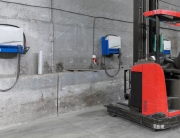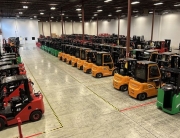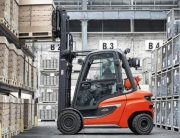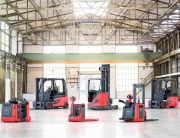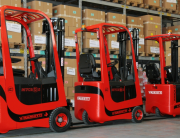There are many different types of forklifts on the market, but most lift trucks consist of a number of key components. Here are the main components of a lift truck. Click on each component listed below the diagram to learn a bit more about it.
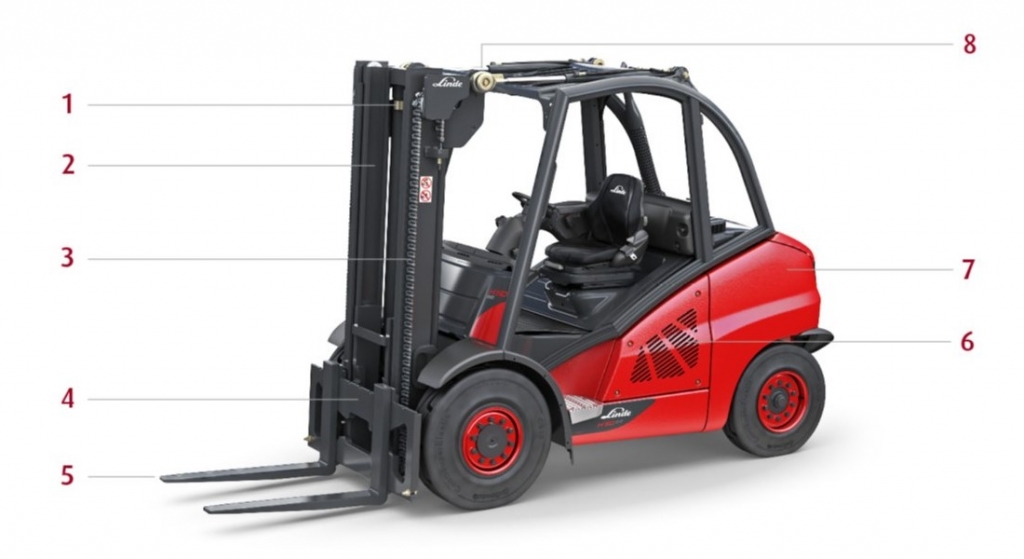
Image Source: Linde Material Handling
If you are in the market for a new or used lift truck, contact us.
Components of a Lift Truck
The lifting device on your forklift is made up of several components: the mast, a fork carriage, a large counterweight and usually two adjustable steel forks.
1. Mast or Hose Pulley
A pulley is a wheel on an axle or shaft that is designed to support movement and change of direction of a taut cable or belt, or transfer power between the shaft and the cable or belt. The pulley is fixed to a hinge and rotates on the axle of the shaft. The pulley on your forklift guides the chain and hoses on your forklift mast to facilitate lifting and lowering.
2. Mast
The mast is one of the main components of a lift truck that is located at the front of your forklift. It allows the forklift to lift loads from the floor up to as high as 425″! The number of channels and length of those channels will determine the maximum lifting height your forklift can reach. There are generally 4 types of forklift masts to choose from:
Simplex Mast (Standard Mast)
This is the lowest cost and simplest style of forklift mast. It utilizes a stationary outer rail and a sliding inner rail with chains to lift the carriage and forks. The height that you can lift is limited by the maximum extension of the inner rails. This type of forklift is typically used for lower lifting heights such as lifting cargo onto the back of a truck. But this style of mast does NOT have any freelift – so as soon as you start lifting the forks the overall height of the mast will begin to change. This sort of mast is not the best for work in low areas or in transport trucks as you risk going through the roof of the trucks.
Duplex Mast
A duplex mast is designed with a hydraulic cylinder in the middle of the mast assembly. It helps to push your load up while the mast itself stays stationary. This is called “Freelift” and many trucks will have approximately 40-50″ of freelift allowing the operator to pickup a pallet stacked on top of another with little or no change to the forklifts overall height. This is very helpful when working in low areas or in transport trucks. When the carriage gets to the top of its inner rails, there are two supporting side rails that help to complete the lifting.
A duplex mast is a great choice for applications such as double stacking your loads, freight cross-docking, and manufacturing component delivery when in low ceiling rooms.
Triplex Mast
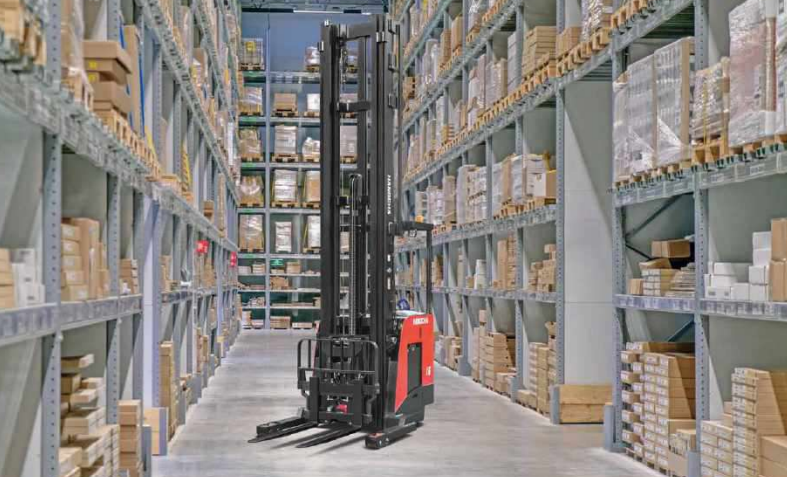
Reach trucks often have a triplex mast so they can extend higher.
A triplex mast has two sliding rails and a single stationary rail. It is designed with a large hydraulic ram in the middle of the mast assembly that does most of the lifting. It also has secondary hydraulic cylinders that lift the center sections and a chain system that pulls the inner section when the mast is fully extended.
This is the most common mast by far in the Lift Truck Industry as it allows strong lifting heights to maximize space utilization and is not too tall to enter and exit transport trucks. Triplex masts also have freelift. You often see triplex masts forklifts and on reach trucks. This lets them reach and extend to greater heights up to 425″. The most common Triple mast is a Triple 188″ mast and these are generally approx. 85″ overall lowered height (OALH).
Quad Mast
A quad mast has four sets of rails and chains to raise and lower its loads. They can reach much higher heights and require advanced training to operate them. It works similarly to a triplex mast, but it has an additional mast channel that gives it even more extension. Quad masts are typically 222″, 240″, 258″ or 277″ and are increasingly popular as buildings get taller and taller. These are freelift masts as well but because of the extra mast channel they do have reduced visibility and additional cost vs a triple mast.
3. Lifting Chains
The lifting chain, also known as a mast or leaf chain, is one of the components of a lift truck that moves your loads up and down the lift mast. The lifting chain is attached to the carriage and then routed up and over the pulley. Your lifting chain will require regular inspections and lubrication to make sure that it doesn’t have any broken, stretched or damaged links. The Ministry of Labor, Training, and Skills Development requires LDI (Lifting Device Inspection) for each forklift in Ontario and it has to be renewed each year. Please contact us if you need LDI for your fleet, our experienced technicians will help you out.
The links on your chain can get damaged if you overload the trucks capacity, or fail to maintain them well. Your chain will also need to be properly lubricated at appropriate intervals. If you notice any damage to your chain, you should get it replaced or inspected by a professional right away.
4. Fork Carriage
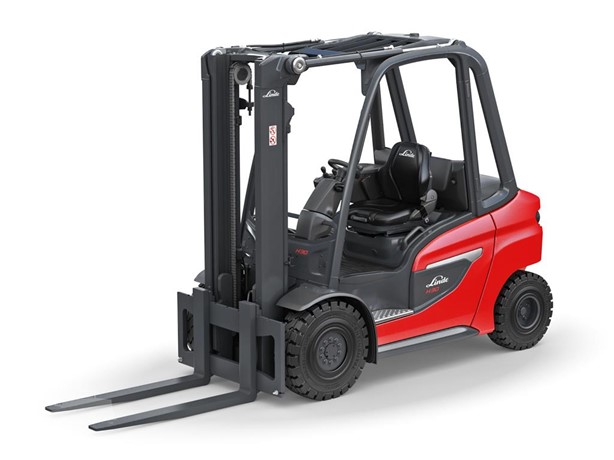
The fork carriage holds the forks of your lift truck.
The fork carriage is a “plate” or a “platform” on the front of the forklift mast that connects the lift mast to the forks or any other attachments such as side shift, roll clamp, etc. It is the part that the attachment and/or forks are mounted to. There are five ITA classes for carriages with different heights depending on the capacity of the lift truck. In addition to the forks, the fork carriage can be used to mount other objects that come in direct contact with your loads such as attachments (Sideshifter or Clamps or Rotators) and the load backrest.
5. Forks/Attachments
Having a set of forks or an attachment mainly depends on application and the load nature, shape, and size. The fork is one of the most important components of a lift truck because it is the mechanism that carries / supports the load 90% of the time when not using a clamp or other attachment. For example, you can insert your forks into a pallet carrying goods and then lift the pallet to move it to another location via the forks. Your forks should be regularly checked for any signs of damage such as:
- Cracks
- Dents
- Broken welds
- Other irregularities
Forks can be Standard Taper or can be a special thinner design for use in lumber or drywall applications. Lumber forks are often thinner but are wider to maintain the fork capacity. They are also polished smooth to minimize friction and to facilitate tight fork entry. If you notice any damage to your forks, or if they appear to be bent you should get them checked out or replaced as soon as possible. Call Ri-Go Lift for an inspection or quote on replacement forks at 416-213-7277 or service@rigolift.com
6. Engine or Battery Compartment
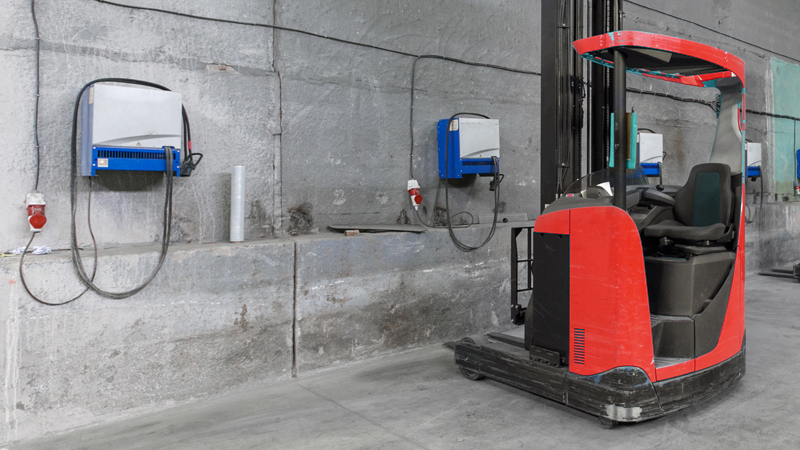
Electric forklift batteries need to be recharged: lead-acid batteries take longer to charge than Lithium-ion.
The engine and battery provide the drive / Power to move both your truck and the lifting unit. You can choose from internal combustion engines or electric forklifts.
Internal Combustion Engines
Internal combustion (IC) forklifts will give you lots of power and they work well in outdoor applications and uneven surfaces. They are available in LPG, Diesel or Natural Gas generally. Some Dual Fuel trucks are set up to run on Gasoline or LPG and the user can alternate between these fuels with the flip of a switch. IC Forklifts are generally lower cost to purchase vs their electric counterparts but DO cost more to fuel and maintain over their life.
Lead-acid Battery:
Electric forklifts that use lead-acid batteries are still a popular choice for applications where it is possible to change your battery or where you only need to use your forklifts for a few hours each day.
Lithium-ion Battery:
Lithium-ion battery forklifts are a great choice if you need to use your forklift for consecutive shifts as they can be charged more quickly than a lead-acid battery or you can charge them during short breaks. Furthermore, they are almost maintenance-free and have longer warranty -Up to 10 years- compared to lead-acid batteries.
7. Counterweight (Counterbalance)
The counterbalance is one of the essential components of a lift truck. It is the weighted part of the forklift that prevents your forklift from tipping over when it is carrying a load. It offsets the weight of the load that you are carrying. Every forklift is designed with a maximum lifting capacity, so it is important that you know what the capacity is for your forklift so you never try to lift above that weight.
8. Overhead Guard with Overhead Tilt Cylinders
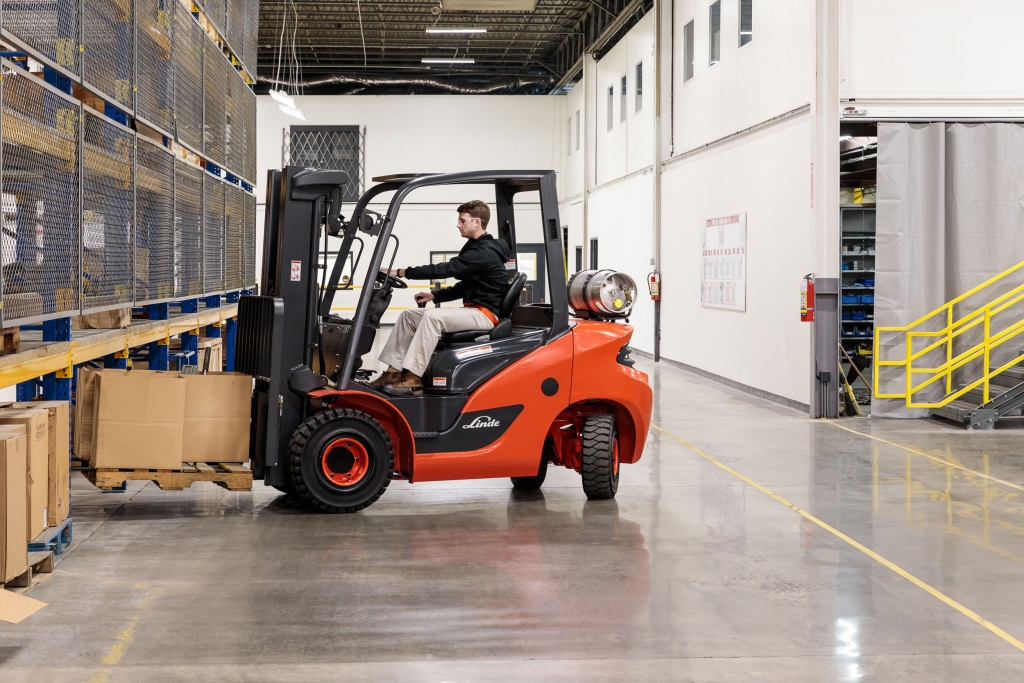
The overhead guard will protect you from falling objects.
The overhead guard is an important safety feature that will protect your operators from falling goods. Forklifts are designed to minimize the risk of falling objects, however, a misplaced load or an accidental bump could result in objects falling onto your cab. The overhead guard will help protect you if this should happen. There are different variations of OHG as below due to the application:
- Standard: it might be different for each model and manufacturer. End-user must be aware of this dimension when the truck is ordered.
- Container: in order to get into a container forklift needs to have a certain range as OHG height. Entry door height is 89″ for standard and 101.5″ for high-cube containers.
- Drive-in: This is a special OHG for forklifts to be operated in warehouses with drive-in racking. Rear columns get narrower in order to get into the racking.
- Full Cab: To operate the forklift in harsh weather conditions whether is hot or freezing, a full cab with a heater or air conditioner is highly recommended.
9. Steer Tires (Rear Tires)
All counterbalanced forklifts have rear steering wheels which is the opposite of passenger cars. They can be either cushion (black, non-marking, treaded) or pneumatic (air, solid, non-marking) Cushion tires are mainly used for indoor and pneumatic are used for outdoor applications. The majority of warehouse equipment comes with polyurethane wheels with some casters for some specific models.
10. Drive Tires (Front Tires)
Similar to steer tires, drive tires can be either cushion or pneumatic for counterbalances forklifts.
11. Capacity Plate / ID Plate
Forklift users can find important information on the capacity plate, also called ID plate in main categories as below:
- Manufacturing: including model, serial number, and manufacturing year
- Structural: Truck gross weight (unloaded), min/max battery weight (for electric forklifts), fuel type
- Operational: Nominal capacity, load center, load capacity at max lifting height. This information is the most important to operate the truck. In case of changing the attachment, capacity plate must be reordered from an authorized dealer with modified capacity.
In the Market for a New Forklift? Contact Ri-Go.
Since 1977, Ri-Go Lift Truck has been serving our customers in Ontario and Quebec with everything they need for material handling. We are committed to providing you with quality service and a high level of customer satisfaction.
We are your authorized dealer for the following top brands:
- Linde Lift Trucks, Power Pallet Trucks, Tow Tractors and Stackers
- Blue Giant Lift Trucks and Pallet Movers
- Komatsu Forklifts and Reach Trucks
- Mariotti Lift Trucks – The Worlds Smallest Lift Truck
- Baoli Lift Trucks
- Advance Sweepers and Scrubbers
- Skyjack Genie Booms and Scissor Lifts
We are also proud to offer you the full lineup of Hangcha forklifts!

In addition to our authorized distributorships, we can also provide you with:
- Large selection of used forklifts
- Operator Training Department – open 7 days a week
- Parts Departments – over $1.4 million dollars of parts on hand for all makes and models
- Service Department – highly trained technicians
- Leasing and Rentals
No matter what your material handling needs are, we can help. Contact us today to let us know how we can be of service.
What Our Customers Are Saying…
“Very professional! Always have what we need when we need it and competitive! A pleasure to do business with.”
– Matthew Headon




